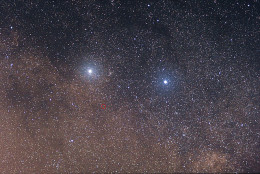The Breakthrough Starshot Initiative made headlines last year when the plan was first announced to send tiny spacecraft to our nearest stellar neighbors. But just how feasible is this initiative? A new study looks at just one aspect of this plan: whether we can propel the spacecraft successfully.
Propelling a Fleet

The Alpha Centauri star system, which consists of Alpha (left) and Beta (right) Centauri as well as Proxima Centauri (circled). [Skatebiker]
To propel the spacecraft, the team plans to attach a reflective sail to each one. When a high-power laser beam is pointed at that sail from Earth, the impulse of the photons bouncing off the sail can accelerate the lightweight spacecraft to a decent fraction of the speed of light, allowing it to reach the Alpha Centauri system within decades.
Among the many potential engineering challenges for such a mission, one interesting one is examined in a recent study by Zachary Manchester and Avi Loeb of Harvard University: how do we keep the spacecraft’s light sail centered on the laser beam long enough to accelerate it?

Beam profile (left) and corresponding potential function (right) for a laser beam made up of four Gaussians. With this configuration, the potential well pushes the spacecraft back to the center if it drifts toward the edges of the well. [Manchester & Loeb 2017]
The Search for Stability
Manchester and Loeb argue that any slight perturbations to the light sail’s position relative to the laser beam — in the form of random disturbances, misalignments, or manufacturing imperfections — could cause it to slide off the beam, preventing it from continuing to accelerate. Ideally, the project would use a sail that could be passively stable: the sail wants to stay centered on the beam, rather than requiring active interference to keep it there.
The scenario that’s been proposed and studied in the past is that of a conical sail propelled by a Gaussian beam. But Manchester and Loeb perform analytic stability calculations to show that such a system will not, in fact, be stable — if the beam gets knocked off the center of the sail, it will not be able to recover its centered position.
Spheres on the Go

Sail position during beam-riding simulations for a spherical sail on the 4-Gaussian beam. Left: When the sail begins with a 5-cm offset from the center of the beam, it oscillates around the center but successfully remains bounded in the x-y plane (rather than drifting off the beam). Right: When noise is added to the beam, the sail oscillates more, but it still remains stable and bounded over several minutes of acceleration. [Manchester & Loeb 2017]
The authors perform a series of numerical simulations to test this configuration, demonstrating that it remains stable even when they introduce deliberate noise into the beam. The simulations show that the beam can stay successfully centered on the spherical sail for at least several minutes — sufficient for the spacecraft to be accelerated to a sizable fraction of the speed of light.
So does this approach make Starshot feasible? It may be a step in the right direction, but challenges still remain. We can undoubtedly look forward to seeing further clever innovations as planning for this project continues!
Citation
Zachary Manchester and Abraham Loeb 2017 ApJL 837 L20. doi:10.3847/2041-8213/aa619b


1 Comment
Pingback: solving stability problems with light sails in a laser beam